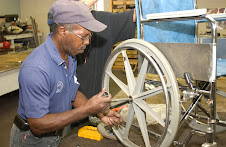This blog will sometimes be a venue to follow up our Pass It On Center (PIOC) Webinars, and that's my purpose in writing about the use of ultra-violet (UV) wavelength light wands to sanitize devices. After the August Webinar on sanitization, a participant asked if UV wands were an appropriate alternative for sanitizing used assistive technology (AT) devices. I really didn't know, so I did a little research.
It would be nice if sanitizing could avoid the use of chemicals that require special handling to protect workers and the environment. We've all seen TV infomercials touting the ease and effectiveness of those handheld UV wands for getting rid of germs in your house. But, will passing UV-C light over a used wheelchair render it properly sanitized for reuse? Perhaps not.
It's true that UV-C light has a germicidal effect, but different "doses" are needed to inactivate different kinds of microorganisms. It's also aborbed by organic materials and has little ability to penetrate. A mini-wand tested by Dr. Philip Tierno, New York University Medical Center, had only minor effect on a sample of e-coli bacteria. (WBZ, Boston, March 18, 2008)
The claim that UV-C is used for disinfection in hospitals is true. What the manufacturers of these consumer products neglect to explain is that UV-C light is used in combination with other methods. One study concluded that shadowed areas still required disinfection by chemicals. Visibly soiled surfaces (especially with organic materials) must be subjected to physical or chemical cleaning before using UV-C light. Hospitals sometimes use a combination of chemical cleaning, UV-C light and special air handling systems.
UV light disinfection is sometimes used in combination with other methods for sanitizing both air and water. One research study concluded that UV "can be used as an adjunct air-cleaning measure, but it cannot replace HEPA filtration." (Atmospheric Environment, Vol. 37, 405-419. 2003)
One of the Indicators of Quality for AT Reuse is that programs sanitize devices in a manner consistent with sound scientific and medical advice. The objective is to make the device safe for the worker and the next user. The method chosen needs to be appropriate for the specific device and consistent with the manufacturer's instructions. In most cases, this involves a combination of physical cleaning with chemical disinfection. UV-C light is not a "magic wand" to replace that process.
This is not to say that you shouldn't use UV wands as an additional method of making the workplace and the AT devices cleaner and safer.
Webinar note: We usually have one Webinar each month on a topic of interest to AT reuse programs. They're free, and you're welcome to join us. Announcements appear at http://www.passitoncenter.org/ or you can be added to our e-mail notification list by sending a request to Liz Persaud at liz@passitoncenter.org.
Thursday, January 13, 2011
Can you wave a wand to sanitize?
Labels: program improvement, quality indicators
AT reuse,
sanitizing AT,
UV light wands
Subscribe to:
Post Comments (Atom)



No comments:
Post a Comment